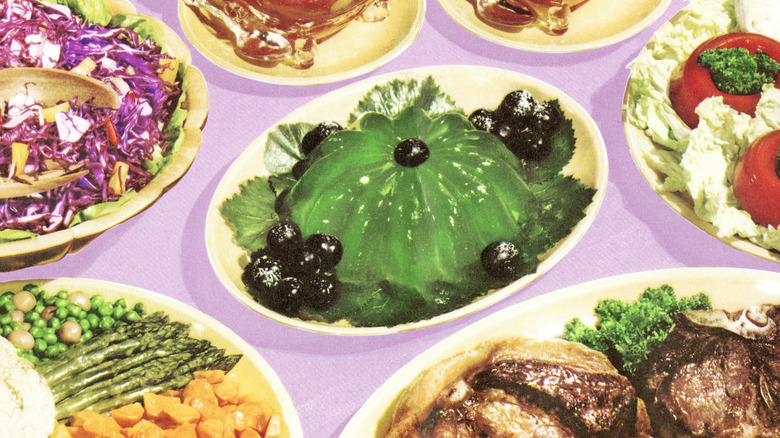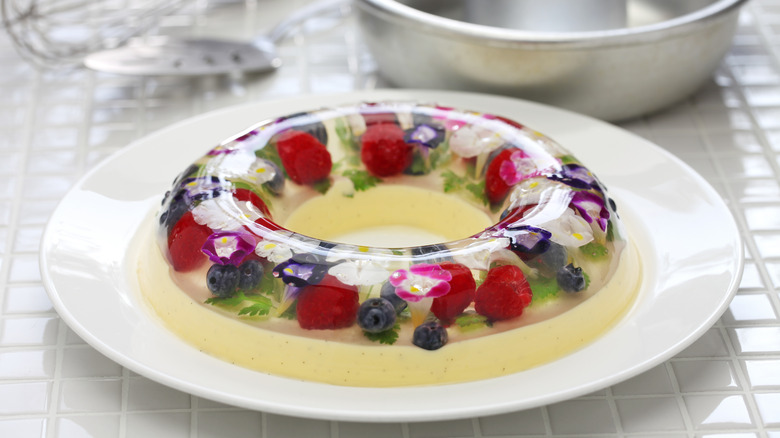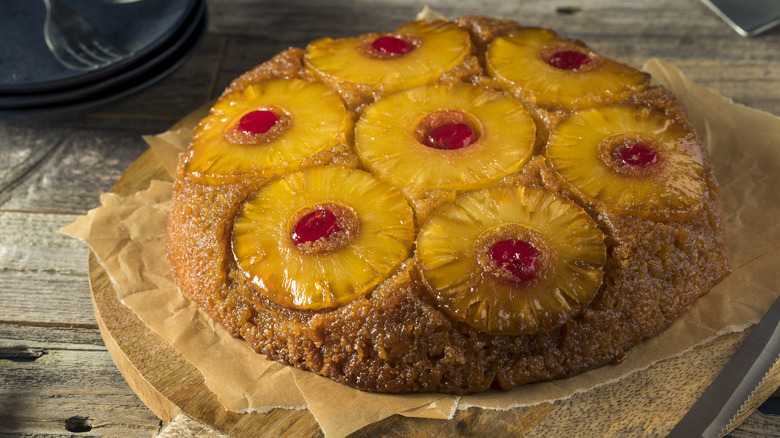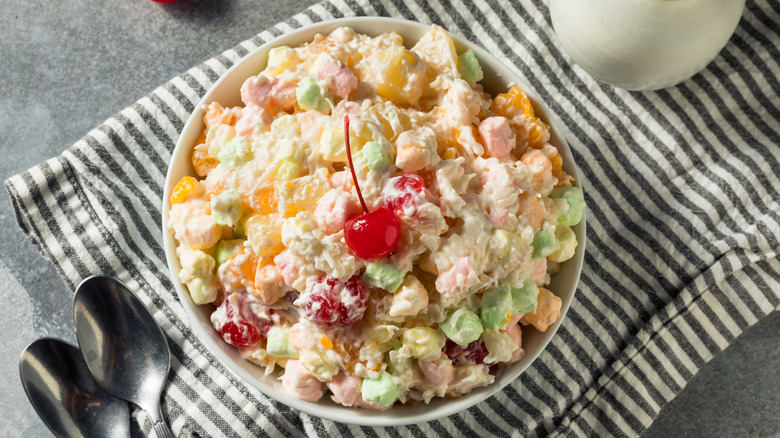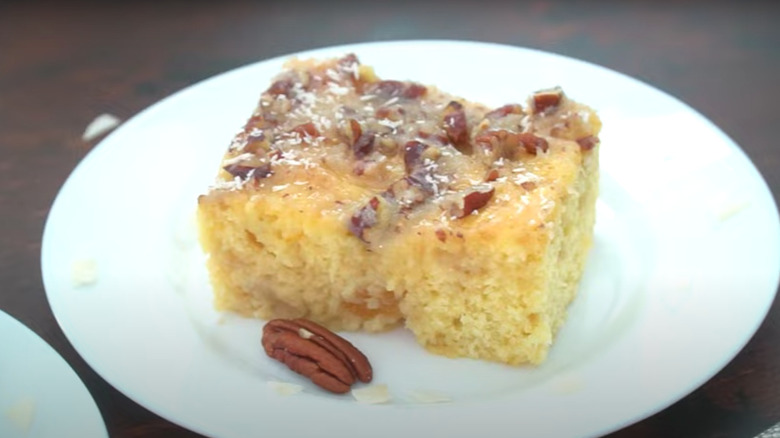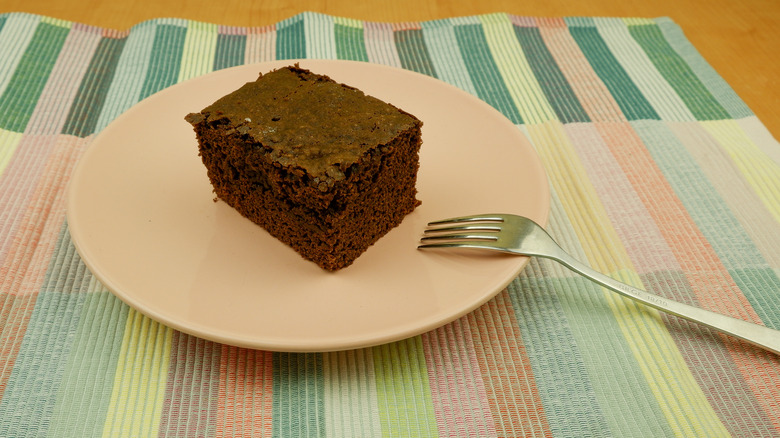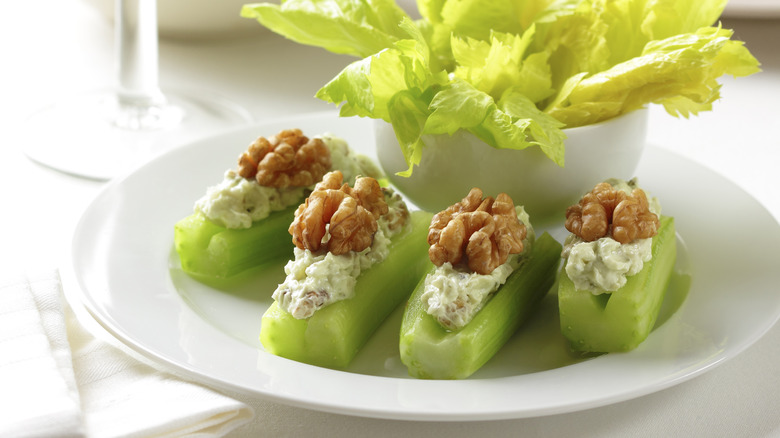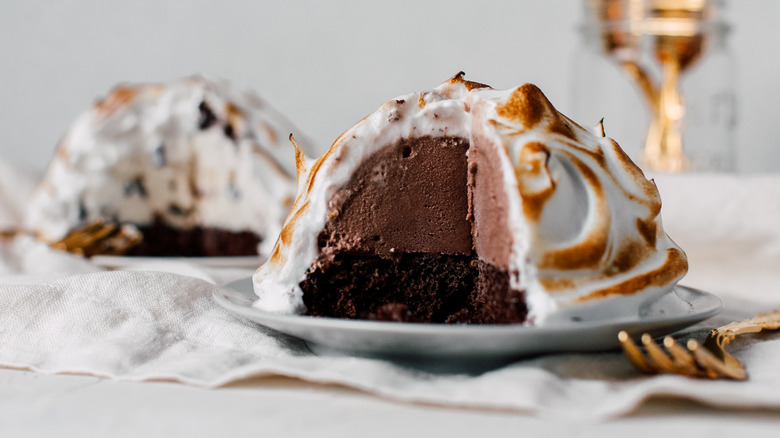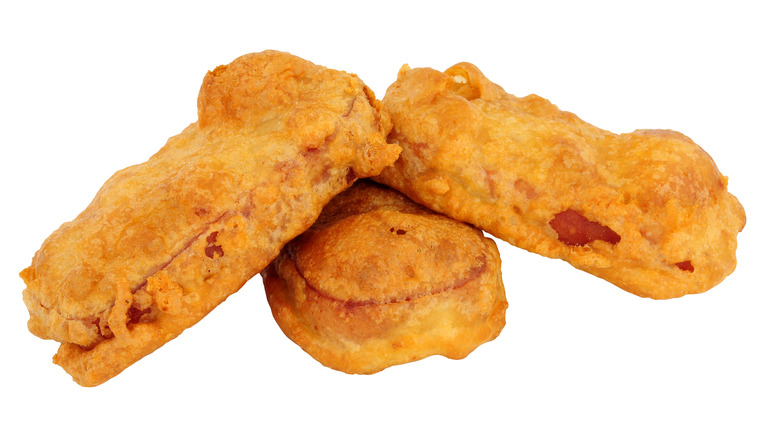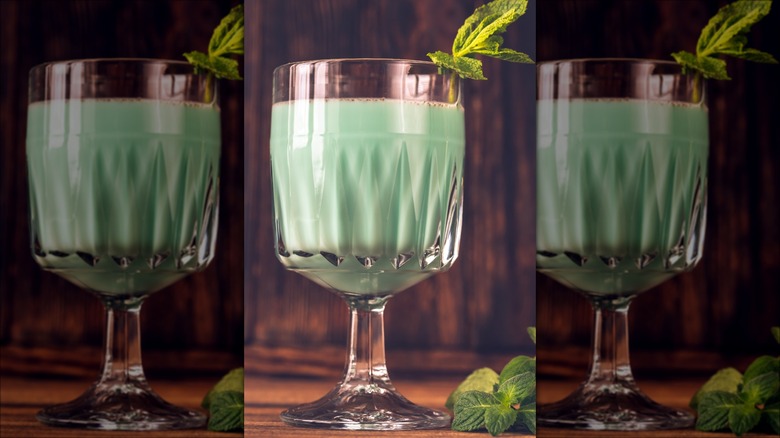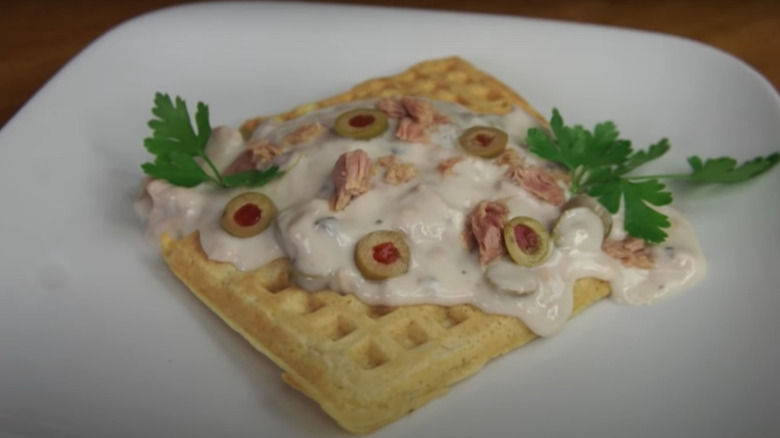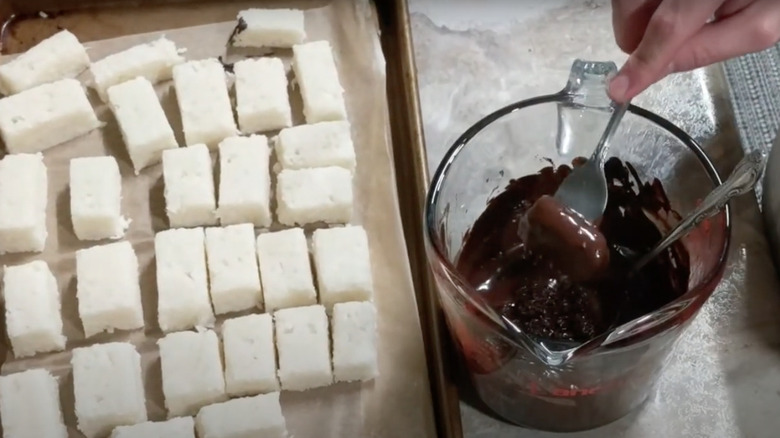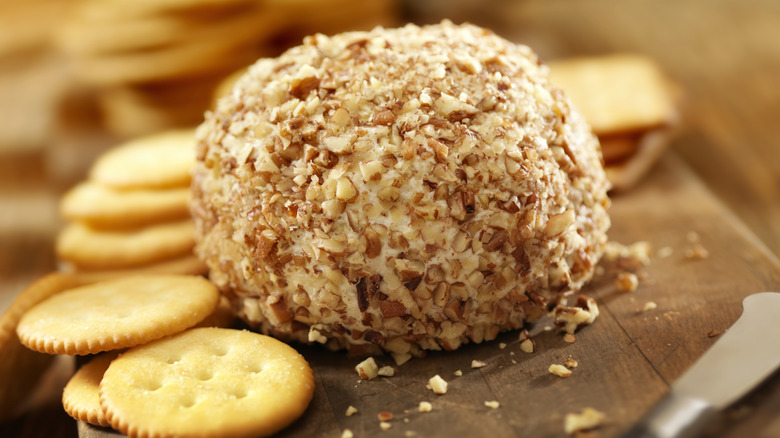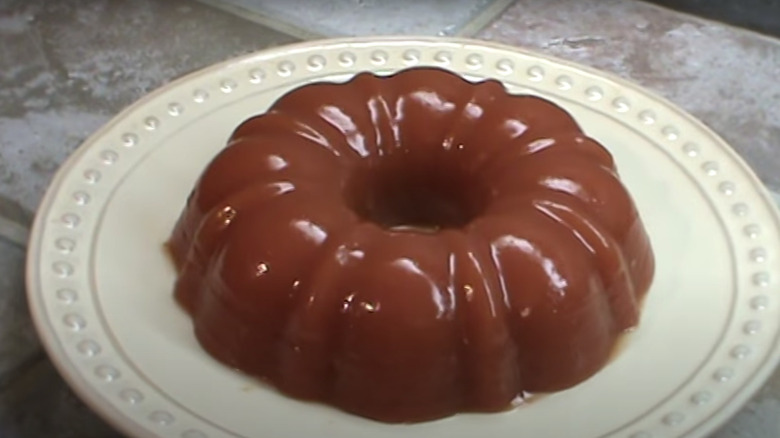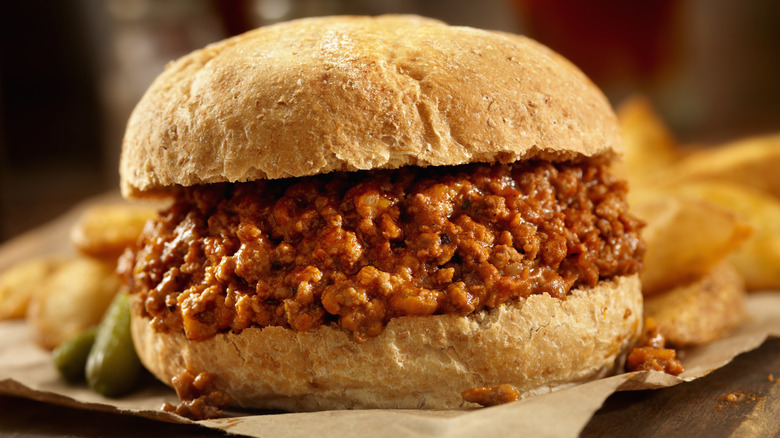14 Quirky 1950s Foods That Deserve A Comeback
During the 1950s, the industrial food complex spit out one quirky recipe after another, each more outlandish than the last. It was a system of recipe production created by the demands of two World Wars that led to the ubiquity of brand-specific cookbooks and the proliferation of Atomic Age food pantries. Fancy molds turned Jell-O into salad and backyard barbecues encouraged people to fire up the grill and forget about the heaviness of the past one bite at a time.
In another historic first, mass produced food, made with the likes of canned soup, frozen waffles, and powdered milk, replaced recipes form scratch in popularity. Given how many canned and frozen foods dominated grocery store aisles during that era, it's no wonder that Andy Warhol's medley of soup can pictures became a thing just a decade later. Food became democratized thanks to the power of mass production. To paraphrase Warhol, "a Coke was a Coke" no matter whether the person drinking it was prince or pauper. And while some of the foods during that era are best left in the past, nostalgia and financial necessity might just bring these quirky '50s concoctions out of the pages of vintage cookbooks and back onto the dinner table.
Jello salad recipes
When Frank Woodward acquired the recipe for the jiggly concoction people called Jell-O in 1899, he probably didn't envision it being turned into a molded dinner salad in the 1950s. But given the gift of hindsight, it's really no surprise that this happened. While technological advances of the age visually described the world of tomorrow, Jell-O salads shaped like the Art Deco buildings of the past ironically dominated dinner from sea to shining sea. Of course, not all the gelatin molds looked like architectural edifices from bygone eras. Jell-O molds shaped like fish, fruit, cornucopias, Christmas wreaths, and four-leaf clovers represented the full force of the mold designers' cleverness.
Those salads were kitschy plates of jiggle. For the homemakers who embraced them, Jell-O salad showed the world that they had not only a fridge to stash the salad, but also the time to make it. Inside these cherry- and lime-flavored concoctions floated apple and orange slices, chopped bananas, and sliced celery for extra crunch. But that's not where the creative Jell-O-making ended. The homemaker of the 1950s pushed the ingredient envelope. During the heyday of Jell-O salads, it was not unusual to see the likes of peeled shrimp immersed in gelatin, but the meat-infusion didn't end there. All manner of proteins, including hot dogs, appeared in those retro salads.
Pineapple upside-down cake
You might say that the upside-down cake arose like all good inventions: out of necessity. Before the pineapple-flavored version of the upside-down cake baked in electric ovens all over 1950s America, would-be dessert cooks made their cast iron skillets their oven substitutes of choice. Skillets-as-ovens came about in the 1800s, a century ahead of the Atomic-Age version of the upside-down cake. Nineteenth-century ovens weren't all that reliable, thus creating the necessity part of the equation. It was electric ovens and canned pineapple that brought the recipe into the 20th century.
Pineapple upside-down cake became seriously popular in the 1950s and 1960s due to the advertising efforts of the Dole Company and a recipe contest, held in the mid-1920s. It was because of the '20s-era contest that pineapple replaced apples and other seasonal fruits as the sweet of choice on the bottom, or should it be the top, of the cake. It wasn't only advertising that made the canned pineapple in the upside-down cake so prevalent in the '50s, however. An explosion of post-war suburban supermarkets, along with those abundant electric appliances, allowed housewives to exercise their creative cooking chops come dessert-making time.
Ambrosia salad with Cool Whip
Around the U.S., but particularly in the South, holiday tables in the 1950s wouldn't have had the same sparkle without a bowl full of Ambrosia salad with Cool Whip. Mid-century iterations of the salad consisted of canned fruit cocktail, orange slices, pineapple, mini marshmallows, coconut shavings, Maraschino cherries, Cool Whip, and even Jell-O sometimes. Its earliest forms, which arose from the kitchens of the mid- to late-1800s, were made up of only sliced oranges, sprinkled sugar, and coconut shavings. Given the disparity between all the versions of the recipe, it's probably safe to say that ingredient availability and the vagaries of food trends contributed greatly to the metamorphosis of Ambrosia salad over the years.
As for its name, its sweet taste inspired its moniker. It comes from Ambrosia, the nectar-like food of the ancient Greek gods. Once the 1950s rolled around, however, the accelerated proliferation of canned foods took Ambrosia out of the heavens and into suburbia. Following the austerity of the war years, foods like Ambrosia salad brought home cooks into the Atomic Age, one pantry of canned fruit at a time. The salad appealed greatly to the sweet-starved taste buds of '50s-era suburbanites, and the explosion of colors, thanks to the variety of fruits and the addition of Jell-O, brought a Technicolor vibe to dinner, which had been bland in the years prior to that decade.
Fruit cocktail cake
Dessert recipes like the fruit cocktail cake epitomize the juxtaposition that became life in the 1950s. On the one hand, societal traditions still placed women squarely in the kitchen. On the other hand, modern appliances and mass-produced foods shortened cooking times and gave them more free time for work outside the home, hobbies, and social functions, like church picnics. At the center of this change were recipes like fruit cocktail cake, which tapped canned fruit and boxed cake mix and took far less time to make than desserts from scratch. It was one of the era's most flexible recipes, perfect for potlucks and family dinners alike.
Fruit cocktail clearly played a central role in the concoction, regardless of whether the cake came from flour or a mix. A frosting, laden with butter, nuts, and that '50s favorite, coconut flakes, topped the cake. But it's the syrupy goodness of the fruit cocktail that sets the cake apart from its fruit-filled cousin, the holiday fruit cake. Instead of chewy candied fruit and dry cake, the pieces of fruit in this cake are soft and the cake itself is moist, thanks to the infusion of fruit-flavored syrup.
Wartime wacky cake
Wartime wacky cake, sometimes called Depression cake, solved some big culinary problems in its day. Unveiled during the early years of the 20th century, its presence mitigated the lack of staples, like milk, eggs, and butter. This was fortunate, given just how much World War I, the Great Depression, and World War II limited the availability of those ingredients, forcing turn-of-the-century dessert-making to improvise.
Recipes for wartime wacky cake tapped substitutes to replace those critical ingredients. The binding and leavening agent found in eggs came from the recipe's combination of baking soda and vinegar. Vegetable oils replaced the moisture that butter brings to most cake recipes. And plenty of powdered cocoa made wartime wacky cake taste good, a bonus considering how common it is for people to turn to comfort food recipes during times of hardship and stress. And given that there are no dairy products in this cake recipe, there's an argument to be made for embracing wacky cake in the 21st century. Many modern eaters gravitate toward vegan food, making this cake a shoo-in for a full-blown sweet treat revival.
Stuffed celery appetizers
In the 21st century, foodies take stuffed celery appetizers for granted, particularly at big celebrations like Thanksgiving. On those occasions, these starters are nearly as ubiquitous as the bird itself. However, that wasn't always the case. The fact is that foods like cheese-stuffed celery only became a big thing in the 1950s when some well-placed ads and a sophisticated transportation system facilitated their transport. It took nearly a century of Thanksgivings to make celery the celebration's chief appetite whetter. It quickly grew in popularity as a palate cleanser as it shared top-billing with another popular snackable from the '50s: olives. Soon, celery represented tradition and no meal that fit that definition would be without it.
It's worth mentioning that fresh fruits and vegetables did not hold the place in the 1950s diet that they do today. Both could be difficult to get a hold of, which is partly why canned vegetables gained such prominence. Also, women who had grown tired of spending all day in the kitchen turned to mass-produced convenience foods to save themselves energy and cooking time when it was time to prep for a special meal. That celery remained on the menu despite this trend has a lot to do with the fact that it could be prepared ahead of time and chilled, making food prep for special meals less cumbersome.
Baked Alaska dessert
While the working and middle classes embraced canned convenience in the 1950s, those with a little more money and slightly more time made elaborate dishes with plenty of wow factor and served them at impressive parties. Few recipes embodied this trend better than baked Alaska. Such a dish sent a message that required no words to understand, but for those who may not speak the language of '50s-era food culture, here's an interpretation: Because baked Alaska cost a great deal of time and money to make, the party hostess who prepared it had social and financial capital to wield.
It didn't hurt that baked Alaska looked like feminine elegance on a platter. A rich layer of meringue, that sort of resembled a woman's bouffant hairstyle, covered layers of ice cream and sponge cake (or some variation thereof). The meringue was fired in the oven to make it crispy, and since that layer was thick and hearty, it was enough to protect the ice cream underneath from melting. The dish's cold/hot character earned it a second name: Alaska, Florida. When the dish first came out in the Gilded Age, a kitchen regiment the size of Downton Abbey's was required to build this tasty tabletop edifice. Thanks to modern inventions like electric mixers and adequate refrigeration, a '50s-era housewife with enough time, money, and gadgets could create this dessert in the space of an afternoon, albeit a long one.
Spam fritters
If you were to go into a fish and chips shop during the war years in England, you'd see something slightly less seafood-y on your platter: Spam fritters. Spam made it overseas during World War II thanks to President Franklin Roosevelt Lend-Lease Act of 1941, allowing fish-loving Brits the opportunity to eat Spam-as-fish fritters as the conflict raged on. And while Spam fritters may have been a fish-and-chips replacement, this dish outlasted the last of the war rations and then some.
The dish also didn't stay in the U.K. Hormel made sure that recipes like Spam and banana fritters were a staple of '50s dinners. While that recipe battered the bananas and not necessarily the Spam, recipes for Spam fritters did exist in the U.S. A can of Spam could make about six or eight of them. Plain flour and a little oil created the most basic canned ham fritter recipe, though next-level versions of Spam fritters might also include mustard and cheese and bit of beer batter for good measure.
Grasshopper shakes
Grasshopper shakes were what happened when the post-Prohibition-era and post-World-War-II fatigue paired with the magic of ice cream. The original version of the drink was invented by New Orleans Restaurant owner, Phillip Guichet, who combined the flavors of crème de menthe and crème de cacao. He served the grasshopper in his restaurant, Tujague. It proved to be so tasty, that the drink took second place in a contest in New York City in the early part of the 20th century.
The original drink did lack one key ingredient that later versions had: ice cream. It wasn't until the 1950s, when cream drinks became popular, that this boozy, minty chocolate ice-cream-headache-waiting-to-happen hit the mainstream. Like many of the foodie trends of this era, the proliferation of grasshopper shakes had as much to do with taste and ingredient availability as they did with the invention of modern gadgets. Before that time, keeping frozen foods like handmade ice cream close by, let alone having the means to turn them into something delicious, was a luxury. But modern freezers and blenders democratized all of that.
Tuna on waffles
Tuna on waffles represented a convergence of 1950s food trends on a plate. For starters, canned everything dominated the '50s food scene. The same could be said for frozen foods. As for this specific dish and how it fit into these trends, the recipe consisted of canned mushroom soup, tuna, and olives combined with a helping of milk and of course, waffles. If, after reading the aforementioned list, you thought something along the lines of "That's a lot of canned food," you're getting the picture. Fast, convenient food, with a serious note of test kitchen quirkiness, was usually on the menu during that era.
While this recipe wasn't nearly as convenient as the era's TV dinners, which only required a bit of oven time and a fork, there were few recipes that represented '50s-era convenience quite like creamed tuna on waffles. It was also an example of a phenomenon that grew to prominence during that time: recipe books that featured brand ingredients or products. When the '50s housewife was making tuna on waffles, she could never forget that it was Campbell's soup that tasted best with tuna. But it wasn't just the canned soup that's notable here. If the home cook in question really wanted to up the convenience factor, she used frozen waffles, which came out in 1953 and were affectionately known as "froffles."
Maine potato candy
So you're making vintage recipe homemade candy. You consult a cookbook, circa 1950, and read off the list of ingredients. Chocolate. Check. Powdered sugar. Check. Potatoes? And mashed potatoes, to be precise. Huh? After reading such a list, no one would blame you for thinking you got two pages in the cookbook stuck together. But where Maine potato candy is concerned, there's no sticky-paged list. You're reading everything right.
As for why mashed potatoes play an integral role in this candy, they bind the ingredients together, keeping the coconut inside compact. Melted chocolate covered the exterior of this '50s treat, and probably further masked the taste of spuds. The potatoes also ensure that the candy didn't get too sweet. Most importantly, recipes like Maine potato candy ensured that women of that era could use up all of their leftovers, a habit that was a throwback from the Great Depression.
Cheese balls
Cheese balls are one of those kinds of appetizers that taste delish and look impressive all while disguising one fact. When they were first invented in the late 1800s, they were little more than leftover cheese bits covered by a crunchy coat of nuts. However, they enjoyed a mid-century revival in 1944 when the recipe for the appetizer showed up in the cookbook "Food of My Friends" by Virginia Safford.
By the time the '50s came around, the cocktail-party era was in full swing and appetizer dips, along with closely related foods like cheese balls, reigned supreme. Recipes for cheese balls showed up in the most unlikely of places, at least by today's standards, including on utility company leaflets. The basic ingredients of this savory vintage appetizer recipe included shredded cheddar and plenty of cream cheese. The nutty crust still remained, though some aesthetically minded homemakers might have decorated the exterior of the appetizer with almond slivers to make it resemble a porcupine.
Tomato aspic
Few foods demonstrated the overdone, industrialized nature of food processing during the 1950s quite like the tomato aspic. For those not familiar with this savory gelatin concoction, picture tomato juice, or something similar, mixed in with clear Jell-O, and poured into a bundt cake mold. Then, the '50s housewife chilled the mold until it resembled a red jellyfish without the flowing tentacles. The proliferation of these dishes during the middle of the 20th century came about largely because General Foods employed 50-plus women in test kitchens around the country. Their primary purpose was to create dishes that could replace from-scratch recipes with the most modern concoctions that food science had to offer.
Dishes like tomato aspics could also be formed into stunning shapes, thanks to food molds, which reinforced the average homemaker's attempts to glamorize dinner. This attitude prevailed during the 1950s. To that end, many tomato aspic recipes didn't just include a tomato-y base but also exotic additions, like crab and shrimp, as well as sliced cucumbers or celery for a bit of crunch.
Souper burgers
Loose meat sandwiches have existed since at least the 1930s, when the sloppy Joe emerged out of the kitchen of a cook by named, you guessed it, Joe. Hunt's officially canned the concept in 1969, but that wasn't the first time that a canned soupy substance came to the rescue of loose meat sandwiches. During the 1950s, plenty of people enjoyed souper burgers, which combined ground beef with a soup, like cream of celery, vegetable, or cream of mushroom.
Campbell's was one of the companies who created brand-specific recipes during this canned-everything era. Although the company's recipe roster often included dishes like casserole, its list of quirky recipes was longer than that. The most outlandish of all of these was the chocolate tomato soup cake, circa the 1930s. While tomato-y chocolate cake may have been quirky, souper burgers were less eyebrow-raising and infinitely more practical come dinner time.
